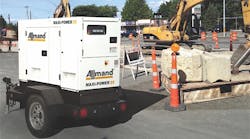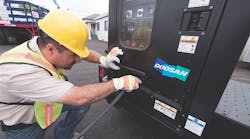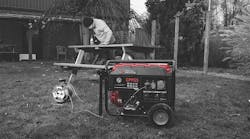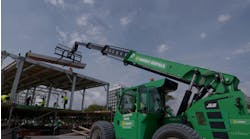Newton’s third law of motion tells us that for every action, there is an equal and opposite reaction. When it comes to selecting a generator, for every non-action, there is also a reaction — and typically, it’s not in the customer’s favor. Savvy contractors and rental associates understand that several factors need to be considered when selecting equipment. If anything is overlooked or omitted, projects run the risk of encountering delays and avoidable expenses that will ultimately cut into profits and result in an unsatisfied customer. While selecting a generator is not exactly advanced physics, the fact remains that variables — the jobsite, required capacity and generator features — need to be considered to help customers make an informed decision.
Rental center personnel can provide excellent guidance for customers looking to rent a generator. These suggestions, however, are only as useful as the information the customer provides. Only with a comprehensive understanding of the equipment that a customer will be powering, along with any other job-specific factors, can a rental center recommend the ideal generator.
To develop a complete picture of what features and power range the customer needs for the job, ask a number of questions upfront. Some jobs require a generator that’s capable of handling significant surge loads without flinching. For others, the ability to switch frequency or run on an external fuel supply can provide valuable jobsite flexibility. The most important factor to consider, and the most common mistake that people make, is suggesting a unit that doesn’t match the power required for the job.
Bigger doesn’t always mean better
While the problem with a generator that’s too small is obvious — not having adequate power to run the necessary tools — an oversized generator can limit a customer’s productivity nearly as much. Ideally, a generator should have enough power to run everything at a site, but not so much that it will run significantly below its rated load capacity. When diesel generators operate below 50 to 60 percent of capacity, they run the risk of wet stacking.
Wet stacking occurs when a diesel engine does not run hot enough to completely burn all of its fuel, resulting in carbon buildup in the exhaust. This can happen when the engine idles or, in the case of a generator, runs too long with an insufficient load. Although wet stacking is nothing new, Tier 4 regulations have forced manufacturers to improve the output-to-emissions ratio. As a result, engines are more prone to wet stacking and thus more likely to require regeneration, which can take the generator out of service for as long as 30 to 45 minutes. Shutting down for regeneration, even once during the day, results in wasted time and lost revenue.
In some cases, contractors may benefit from two smaller generators, as opposed to a single larger unit, to avoid wet stacking. This provides the option of shutting down one unit to adjust for demand. Although this may increase the rental costs, it can deliver savings for some by reducing downtime and improving application flexibility. It also affords contractors the benefit of being able to split the two generators between jobs if needed.
Great capacity — great productivity
For jobs requiring a generator to run around the clock, an undersized fuel tank will not only limit productivity but also become a nuisance. To provide more time between fills, suggest a generator equipped with a large fuel tank that boasts runtimes exceeding 24 hours. To further increase the time between refills, recommend a generator capable of switching from its on-board fuel source to an external one. Drawing from an external source can drastically extend runtime compared to units limited to an onboard fuel supply.
With or without an external fuel supply, if levels are not monitored properly, the generator may run dry. For rental centers, this often requires sending a trained technician to prime the system to get it operational again, while guaranteeing downtime for the customer. Some manufacturers have eliminated the need for this service call by adding an automatic fuel priming system. This system allows the operator to simply turn the key back to start and the system will prime itself. Although customers never intend to run a generator completely out of fuel, it does happen, and offering a self-priming generator can reduce downtime for the customer and eliminate a service call for a rental company.
More with less
Equipment that can perform multiple functions is inherently more useful. Granted, generators basically do one thing — generate electrical energy. However, by offering generators with multiple output settings, rental centers can increase the versatility of their offerings for customers.
Units equipped with a frequency switch are beneficial if the generator will be used with both 50- and 60-hertz equipment. Many generators can switch between both frequencies to accommodate different equipment. Similarly, generators that offer multiple voltage settings, as well as the ability to switch between single- and three-phase electric power, provide operators with improved versatility. Additionally, if a customer will be using the generator to start large motors with variable loads, steer them toward a unit with a heavy-duty, oversized alternator and enough power to start the motor without surging.
Location, Location, Location
Finally, it’s always important to understand where the generator will be used. Certain locations require extra precautions be taken to prevent the risk of site contamination. For sites with strict guidelines, recommend a unit with an internal leakage reservoir. Some provide full fluid containment with a reservoir capable of holding more than 100 percent of the system’s total volume, ensuring there is no risk of environmental damage.
Geography can also play a role in the recommendation process. If a generator will be used at higher elevations, be sure to account for diminished performance. As a general rule, engines lose about 3 percent of their power for every 1,000 feet of elevation. While this applies to all generators, be sure to suggest a unit with enough power to offset diminished output.
At higher elevations, cold temperatures may also be a factor. Anytime cold weather is expected, suggest a generator equipped with an arctic package. These units often include heavy-duty batteries, block heaters and battery chargers to ensure consistent starting and reliable performance as temperatures drop.
Choose wisely
From geography and equipment specs to power output and safety, accounting for all of these variables is important when helping a customer select the ideal generator. Sir Isaac Newton may not have had standby power in mind when he formulated the third law of motion, but he definitely understood cause and effect. Investing time upfront to understand what a customer needs will help maximize their ROI and increase the likelihood they return in the future.
Brian Northway is product manager, Allmand Bros. Inc.









